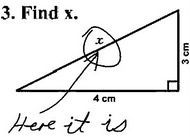"They're too smart to jump through hoops the way those dumb dolphins do"
Two concepts here that charm me:
- What kind of person thinks up ways to train manatees to do tricks?
- "Rather than the manatee's brain being unusually small for its body, the situation may be the other way around: that its body, for sound evolutionary reasons, has grown unusually large in proportion to its brain." There's got to be a way to use this kind of spin in our daily lives. Leave suggestions.
Sleek? Well, No. Complex? Yes, Indeed.
By Erica Goode for the New York Times, August 29, 2006
The manatee, sluggish, squinty-eyed and bewhiskered, is likely to have its rotund bulk compared to "a sweet potato," its homely, almost fetal looks deemed "prehistoric" — terms applied by startled New Yorkers this month to a Florida manatee that made an unexpected appearance in the Hudson River.
Cleverness is unhesitatingly ascribed to the dolphin. But the manatee is not seen leaping through hoops or performing somersaults on command ... Writing in 1902, a British anatomist groused that manatee brains — tiny in proportion to the animals' bodies and smooth as a baby's cheek — resembled "the brains of idiots."
Far from being slow learners, manatees, it turns out, are as adept at experimental tasks as dolphins, though they are slower-moving and, having no taste for fish, more difficult to motivate.
Brain size has been linked by some biologists with the elaborateness of the survival strategies an animal must develop to find food and avoid predators. Manatees have the lowest brain-to-body ratio of any mammal.
But, as Dr. Reep noted, they are aquatic herbivores, subsisting on sea grass and other vegetation, with no need to catch prey. And with the exception of powerboats piloted by speed-happy Floridians, which kill about 80 manatees a year and maim dozens more, they have no predators.
Rather than the manatee's brain being unusually small for its body, the situation may be the other way around: that its body, for sound evolutionary reasons, has grown unusually large in proportion to its brain.
The manatee must consume 10 percent of its 800-pound to 1,200-pound body weight daily. Hugh, 22, and Buffett, 19, captive manatees at the Mote Marine Laboratory in Sarasota, Fla., are fed 72 heads of lettuce and 12 bunches of kale a day.
The manatee is good at what it needs to be good at.
Manatees distinguish colors. The orange of carrots in a trainer's hand can inspire a captive manatee to an uncharacteristic speed.
In 2003 ... manatees were trained to discriminate between two underwater panels of evenly spaced vertical lines, swimming toward the correct panel for a reward of apples, beets, carrots and monkey biscuits.
Yet far more valuable than sight in murky water is an acute sense of touch, and it is here that manatees excel.
In testing, Buffett, Hugh and other captive animals have proved just how acute a manatee's tactile sense can be ... manatees can detect minute differences in the width of grooves and ridges on an underwater panel. A manatee tested by a team of researchers in Germany could distinguish differences as small as 0.05 millimeters.



 A few of my daughter
Melina's great posts:
A few of my daughter
Melina's great posts:








1 Comments:
Rather than the driver's body being unusualy small for it's SUV, the situation may be the other way around: that the SUV, for basic profit motive, has grown unusually large in proportion to the driver?
Post a Comment
<< Home